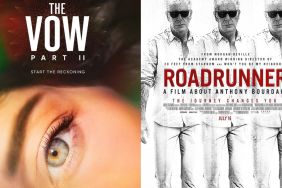Kirby Dick (filmmaker)
David Ansen (critic, Newsweek)
Darren Aronofsky (filmmaker, “Requiem for a Dream”)
Jamie Babbit (filmmaker, “But I’m a Cheerleader”)
Maria Bello (actress)
Atom Egoyan (filmmaker, “Where the Truth Lies”)
Stephen Farber (critic)
Martin Garbus (lawyer)
Mary Harron (filmmaker, “American Psycho”)
Richard Heffner (former MPAA chairman)
Cheryl Howell (private investigator)
Lindsey Howell (private investigator’s daughter)
Wayne Kramer (filmmaker, “The Cooler”)
Lawrence Lessig (writer)
Kimberly Peirce (filmmaker, “Boys Don’t Cry”)
Kevin Smith (filmmaker, “Clerks” etc.)
Matt Stone (filmmaker, “South Park”, “Team America”)
Michael Tucker (filmmaker, “Gunner Palace”)
John Waters (filmmaker, “A Dirty Shame” etc.)
MPAA Raters as themselves
Directed by Kirby Dick
Summary:
Kirby Dick’s documentary is as entertaining as it is informative, a real eye-opener about how the MPAA works… or doesn’t work, depending on how you look at it.
Story:
Filmmaker Kirby Dick (“Twist of Faith”) takes an in-depth look at the MPAA ratings system, trying to find out how they decide how to rate movies, as well as hiring a private investigator to find out exactly who it is that is giving these ratings.
Analysis:
It’s funny how few people ever talk or think much about the MPAA ratings system unless there’s some sort of controversy involved. In the last decade, that controversy usually involves movies being stamped with the dreaded NC-17 rating, which limits that film’s possibilities for distribution. For his sixth documentary, filmmaker Kirby Dick turned his cameras on the film industry itself, trying to find out how this system works and learning that it’s even more frustrating than he originally thought when he’s forced to deal with it directly.
It starts out innocently enough with Kirby speaking to filmmakers who have had problems with the MPAA rating system, including Kimberly Peirce (“Boys of Cry”) and Jamie Babbitt (“But I’m a Cheerleader”), two lesbian filmmakers who found themselves singled out by the MPAA for the homosexuality in their movies. Matt Stone details the problems he and Trey Parker experienced with the MPAA for all their movies, but how their studio movies “South Park” and “Team America” were treated differently than the independently financed “Orgasmo.”
Doing these interviews piques Kirby’s interest in how the MPAA decides which movies deserve to get rated in a way that might keep them from being seen by a mass audience. His biggest issue seems to be that we don’t know whom these people are that stamp the ratings on a movie, because the MPAA has sworn their identities and the system they use to secrecy. With that in mind, Kirby hires a private investigator to find out the truth, thrusting us into a world of espionage, as this investigator starts following the cars leaving MPAA headquarters trying to find out which of them are actual film raters.
This investigation is interspersed with historical information about the MPAA and its stunted evolution, as well as thoughtful interviews with the filmmakers who have been most affected by the system. Wayne Kramer and Maria Bello talk about their fight for “The Cooler,” Darren Aronofsky and Mary Harron talk about “Requiem for a Dream” and “American Psycho”, and the two most recent MPAA victims, John Waters and Atom Egoyan, discuss the problems they had, especially in their own interaction with the MPAA to appeal the rating. Even Kevin Smith had problems, but that was about getting “Jersey Girl” down to a PG-13 rating. All of the interviews are well placed and edited to maintain the flow of the film’s story, accompanied by fun graphics to illustrate certain points.
Kirby’s approach to investigative filmmaking follows a same M.O. as Michael Moore, not only in the extreme methods used to get information, but also by making himself the subject of his own documentary. At least, Kirby is a bit more affable about his own struggles with the MPAA and doesn’t make his presence that known in the investigation. Although it’s a tedious process–do we really need to know so much about this private investigator?–it leads to a few thrilling moments and a great payoff, as they get closer to finding out the identities of the secret MPAA raters. The important thing is that he’s able to prove his theory that they aren’t what the MPAA claims, and yes, they do actually reveal their names, as well as their backgrounds.
More importantly, the movie includes a lot of the footage that was cut out from other movies to get an R-rating, which immediately puts Kirby’s own doc at risk of getting an NC-17 when he decides to put it through the system to see how it works from the inside. At this point, the film almost turns into an Ouroboros (the snake eating its own tale), as the MPAA ends up having to watch and rate a movie about its own members, which takes the entire organization to task. It’s surreal to think about how anyone could watch a movie like that without any sort of bias.
Kirby’s appeal process becomes even more outlandish, as the MPAA makes it impossible for him to defend himself or his movie. He doesn’t have quite the luck as Michael Tucker who appealed the R-rating for his expletive filled war doc “Gunner Palace” and was able to convince the MPAA to give it a PG-13 rating. It gives a little bit of hope that this flawed system can be “beaten” though the movie does leave you wondering why so many filmmakers are willing to put themselves through such an ordeal rather than just doing what Kirby Dick does, by releasing his film without the imposed rating.
The Bottom Line:
Anyone who ever wondered how the MPAA decides how movies are rated and by whom should enjoy this documentary that’s informative but never preachy, even if it’s obviously biased against the system from the start.










